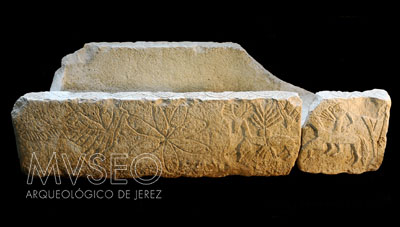CHRISTIAN SARCOPHAGUS WITH DECORATED FRONT
Visigoth Period
CHRISTIAN SARCOPHAGUS WITH DECORATED FRONT
Limestone.
Length: 158 cm. Height: 40 cm. Total width: 68 cm.
Visigoth period. Around 6th century A.D.
Origin
Country house in La Peñuela. Jerez de la Frontera. Cádiz.
Description
The features – its smaller size, existence of a drain hole and decorative grape stem weaving around the upper edges of the lateral walls - seem to indicate an original use as a basin, probably later reused as a sarcophagus. This would match the decoration on its front. It depicts two different scenes bearing no apparent relation to each other – each was even made using different techniques. The first scene was achieved through silhouetted simple linear incisions, and depicts a peacock with open tail. The peacock is pecking at a large and very crudely hewn seven-petal rosette. The second scene is in relief (although it does not particularly stand out) and displays a rider on horseback trying to hunt a stag in the countryside. Two trees have been depicted very simply. They are all symbols linked to the world of the dead and resurrection.
Bibliography
- Rodríguez Oliva, P. (2001): “Talleres locales de sarcófagos en la Bética”. El sarcófago romano. Murcia, pp. 150-154.
- Beltrán, J.; García, M.A. y Rodríguez Oliva, P. (2006): Los sarcófagos romanos en Andalucía. Corpus Signorum Imperii Romani. Murcia, pp. 112-115.

